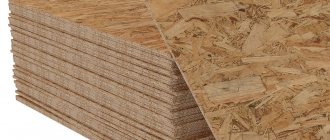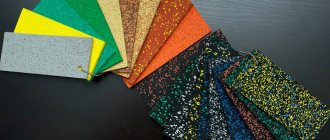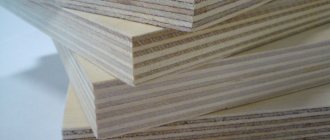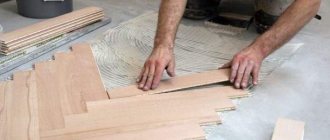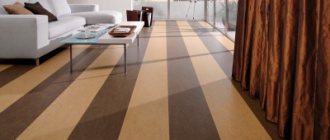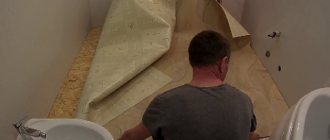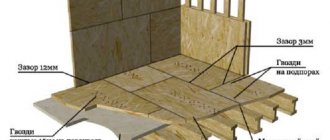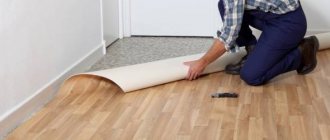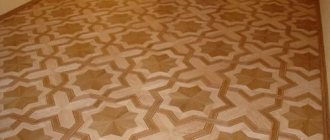SHARE ON SOCIAL NETWORKS
FacebookTwitterOkGoogle+PinterestVk
Linoleum gained popularity among other types of covering several decades ago, when it was actively laid on the floors of Khrushchev-era apartment buildings directly on concrete floors. During this time, manufacturers have constantly worked to improve the quality of the material, introduce new technologies and improve the design. It is laid on different bases. This article will tell you how to properly install a linoleum floor on a concrete floor.
Linoleum is the most popular flooring material
Recommendations and steps for laying linoleum on a concrete floor
Owners of apartments in both new buildings and old buildings usually ask a typical question during the renovation process: is it possible to lay linoleum on a concrete floor? And the most popular answer both on Internet forums and from experts: linoleum is the main flooring material in modern buildings.
In order for the linoleum coating of a concrete floor to be successful, it is necessary to adhere to all stages of installation.
The process of laying linoleum includes several stages:
- selection of suitable material;
- preparing the base and leveling the surface;
- surface waterproofing;
- calculation of material consumption for installation;
- marking and cutting linoleum;
- fixing the covering to the floor using adhesives;
- mechanical fastening using skirting boards.
Each stage has its own substages, features and importance. The guarantee of successful work lies in the correct choice of linoleum, glue, and in preparing the base. The process becomes much more complicated if it also involves installing a heated floor under linoleum on a concrete floor.
During installation, the coating must be carefully straightened to remove air.
Experts recommend not to neglect the stage of leveling the floor under linoleum before laying, as this is the key not only to the beauty of the surface, but also to the longevity of the coating. The smoother the base, the longer the linoleum lasts.
How to prepare the floor before laying
Laying linoleum on a concrete floor begins with preparing the base, even if you plan to use a substrate. High-quality preparatory work is the key to long service life of the flooring.
The first thing to do is evaluate the rough coating. It is believed that this material is able to withstand minor irregularities and chips. However, in reality, all this, of course, reduces its service life: concrete sand and dust increase friction between the floor and the deck, which leads to wear and tear of the material and the formation of cracks.
- If the subfloor is uneven, has a difference in levels, crumbles and has large cracks, builders advise removing it completely and then making a new screed. You can use cement, gypsum or self-leveling mixtures.
- Small cracks expand and are filled with mortar.
- The entire surface is primed.
- The rough coating must be clean. It is advisable to wash it and let it dry.
- Simply laying linoleum on concrete is not suitable for everyone, because the floor will be cold. It is worth taking care to protect the structure from moisture and thermal insulation.
Instagram @alexandr_v_k
A new screed is necessary if the floor is uneven or has cracks. The rough coating must be clean. It is advisable to wash it and let it dry.
Preparing the floor for linoleum: leveling the base
Regardless of the type of linoleum, before installing it you need to prepare the base. This is an important factor affecting the service life of the roll coating. It would seem that even minor cracks, depressions or protrusions can lead to rapid abrasion of the linoleum in these problem areas. Therefore, the base must have as smooth a surface as possible and also be clean.
If you have a concrete floor, you need to take care of the noise and heat insulation of the surface. The base requires special preparation when laying heated floors under linoleum. We will talk about this in a separate section.
Important! You should not use sheet materials to level the surface of an uneven concrete base, as they will sooner or later deform under the contours of the floor and subsequently modify the linoleum.
Before leveling the floor, it is necessary to remove the old coating
Typical preparation of a concrete base consists of the following steps:
- Dismantling the old coating. Before leveling the floor under linoleum, it is advisable to remove the old covering. In rare cases, you can leave the old linoleum. But the covering of linoleum tiles definitely needs to be removed, this also applies to old substrates and insulating layers. There should be a bare concrete base left. The surface is thoroughly cleaned of dust and other contaminants.
- The assessment and diagnosis of a concrete foundation is determined by the totality of all defects, including bulges, slopes, dents, and drops. If they make up more than 20% of the total area of the room, then it is necessary to perform a concrete screed or fill the surface with a self-leveling mixture. Such measures will help make the base as smooth as possible.
- Elimination of minor flaws. If a screed is not necessary, then it is enough to spot-fix minor damage. Particular attention should be paid to defects between concrete floor slabs. To do this, use putty, epoxy resin or cement solution mixed with drying oil. The cleaned and smooth surface is coated with a primer.
- Laying layers of heat, sound and waterproofing. Before laying linoleum, you need to take care of thermal insulation, since concrete is cold in itself, and even a coating with a thermal insulation backing will not save the situation. For thermal insulation, you can lay fiberboard sheets or plywood on the floor under the linoleum.
For thermal insulation of the floor, you can use plywood, polystyrene foam or fiberboard sheets
For waterproofing, it is recommended to use polyethylene film no thinner than 200 microns. It is laid with an overlap of at least 20 cm and overlapping the walls by 5-6 cm (the excess is removed after laying the linoleum). Masking tape works well for soundproofing.
We make high-quality joints - we get a beautiful floor
To obtain a high-quality linoleum coating, knowledge of laying technology is not enough; if a roll is used that is narrower than the width of the room, then you have to lay several strips of material and weld the joints. There are two welding methods: cold and hot. The first method is more accessible, as it does not require special tools and a lot of time. To work you need masking tape, a long strip, special glue and a sharp knife. The gluing algorithm is a sequence of steps:
- We lay the linoleum sheets overlapping.
- Having attached the bar, we draw a line along which we will cut the canvas.
- Next, we make a cut along the drawn line.
- Having removed the cut strips, we join the canvases.
- We stick masking tape along the cut and cut a gap in it along the joining line.
- Pour glue into the resulting gap.
- When the glue dries, remove the tape.
Hot welding takes more time and requires precision and accuracy, but as a result, the seams become invisible and the service life of the coating is extended. To carry out the procedure, special welding equipment and a polymer cord are required. We join the edges of the canvases so that the pattern matches. We place the cord in the welding machine and heat it to 300 degrees. We start work from the wall, moving towards the middle of the room. We pour the melted cord into the gap between the sheets. When the material hardens, cut off the excess with a sickle knife or other sharp tool. We get a dense, inconspicuous seam.
Flooring under linoleum on a concrete floor: choice of material
A practical approach involves taking into account the structure and wear resistance of linoleum. Depending on its structure, linoleum is divided into homogeneous (single-layer) and heterogeneous (multilayer). The latter option is usually used in domestic conditions, since it already has the necessary base, most often insulated or waterproofing.
There are two most common types of linoleum that are used as a coating for concrete floors in apartments: polyvinyl chloride (PVC) coating and natural linoleum, which contains cork meal, tree resin, lime and linseed oil. Both of these types are harmless to health, resistant to bacteria and repel fat.
Helpful advice! For the kitchen and hallway, where traffic is highest, it is better to take semi-commercial or even commercial class linoleum. In public institutions, the most popular option is commercial homogeneous linoleum.
For domestic premises it is better to purchase multilayer linoleum
Another classification depends on the degree of resistance of linoleum to stress. In this case, roll decorative coatings are divided into household, semi-commercial and commercial. Judging by the names, household coating is intended for residential premises, but this is only at first glance. It is, of course, inexpensive, but has low wear resistance, that is, the price corresponds to the quality. All rooms in the house have different functionality, which should be taken into account when choosing floor coverings.
The 1.5 mm thick household coating is suitable for offices, living rooms and bedrooms. For the corridor, kitchen and children's room, it is better to take linoleum with a thickness of at least 3 mm, which is easier to protect from mechanical damage.
Aesthetic characteristics of linoleum of different collections
First of all, it is worth noting that the color of the flooring should match the overall design of the room. The choice of quality material also depends on the manufacturer. Tarkett has been considered the most popular company in the flooring production market for many years. Commercial, semi-commercial and household linoleum can be found in different series from this supplier.
Taste preferences were taken into account in different versions by linoleum manufacturers. For example, the Discovery series of Tarkett linoleum maximally conveys all the beauty and charm of natural materials, allowing them to be brought closer to natural ones without causing harm to nature. The Tarkett Grand linoleum collection is a variety of decor and fantasy patterns. It includes both fancy lines and the maximum imitation of natural parquet.
The construction market offers a wide range of linoleum
In turn, Tarkett Idyll linoleum is distinguished not so much by aesthetics as by practicality and increased durability. It can withstand the load from hairpins and sharp legs of mobile furniture. The material has good heat and sound insulation. This series includes different models, including those designed for high-traffic areas. An example is Tarkett Atlant 1 linoleum from the Idylle Nova collection. The wear resistance of this coating allows it to be used in offices with average load intensity and children's institutions.
Calculation of linoleum sizes: width standards, taking into account features
When calculating the size of the canvas, you need to take the material with a reserve - a few centimeters more than the area of the room. This is quite easy to do in standard square and rectangular rooms. It is enough to measure the dimensions of the room and add 10 cm on each side.
Helpful advice! An online calculator will help you accurately calculate the required amount of material. Indications of the length and width of the floor are entered into the windows (for example, the width of linoleum is 2 m). How many meters of linoleum will be required from such a roll will be indicated in a special window.
If there is a pattern on the linoleum, then you need to take into account the joining allowances
In rooms with complex outlines, you need to approach the cutting process more carefully and make a larger margin. When buying linoleum with a pattern, you should also take into account the allowances for joining the pattern. It is equally important, when purchasing a coating, to check that the batch number indicated on the labels of the linoleum rolls matches.
To avoid seams on the floor, the width of the roll should be equal to the length of one of the walls of the room. The standard width of linoleum is 2 m - 5 m in half-meter increments. A variety of coating sizes allow you to calculate the most economical option and avoid joints.
A simple secret to avoid seams is to take the size of the roll according to the length of one of the sides of the room. For example, in a narrow hallway 1.8 x 6 meters, linoleum 2 meters wide is suitable. How many meters of linoleum will be required depends on the length of the hallway. In this case it is 6 meters.
When deciding where to buy linoleum, you can resort to classic options and visit a hardware store. Modern consumers are increasingly using the order of goods via the Internet; this service - online purchases and delivery - extends to flooring.
In order not to make a mistake with the size of linoleum, you need to measure the room and add 10 cm to each side
Classification of linoleum
Linoleum is divided into types according to its characteristics.
- By composition:
- natural;
- PVC linoleum.
The top layer of natural linoleum consists of natural components - resin, wood flour, crushed cork, mineral fillers, and is based on jute fiber. Although such linoleum does not burn, does not emit harmful substances and has an antistatic effect, it has low moisture resistance, a small selection of colors and a fairly high price. PVC linoleum consists of a synthetic polymer with the addition of plasticizers, fillers and pigments. This option is wear-resistant, low maintenance and durable, and has a wide selection of colors and textures.
- Based on:
- without basis (baseless);
Photo: linoleum without base
- with a base (main).
Photo: linoleum with base
Baseless linoleum is very thin, so when laying it, careful preparation of the base is required.
- By structure:
- single-layer (homogeneous);
- multilayer (heterogeneous).
Homogeneous linoleum consists of one layer with a thickness of at least 2 mm. This material can be sanded and laid without seams - they are easy to weld due to their homogeneous structure. Although the color range of this type of flooring is small, it can be combined with other colors. Heterogeneous linoleum is based on fiberglass, on which functional layers are applied: on the bottom - a substrate and a heat-insulating layer of foamed polymer or non-woven fabric, on top - decorative and protective layers.
- By area of application:
- domestic;
- semi-commercial;
- commercial (production).
Household linoleum is used in rooms with low traffic - a bedroom, a nursery or a pantry. Semi-commercial linoleum is suitable for the living room, hallway and kitchen, and commercial linoleum is suitable for office, public and heavily loaded buildings, as well as balconies.
How much does it cost to put 1 sq. m of linoleum: consumption and cost
It is logical that linoleum is the most important component in the installation process; it is where the main costs fall. In addition, it is necessary to take into account the financial resources required to purchase other materials. For example, without backing and glue, installation of linoleum is impossible.
In order to calculate how much it costs to lay linoleum per square meter, as well as the total cost of laying the covering on a concrete floor, you need to add up the cost of the following materials:
- linoleum;
- cement, putty or self-leveling mixture for the base;
- insulating boards, films and elements for their fixation;
- glue or mounting tape for fixing linoleum;
- skirting boards and materials for their fastening.
To calculate the cost of laying 1 sq. m of linoleum you need to add up the cost of all materials necessary for the work
Nowadays it is not a problem to buy cheap linoleum. Where to buy a quality one is a more difficult task, and in this matter it is better to trust prestigious stores and professionals.
The price of linoleum per square meter depends on the above qualities of the coating: material, wear resistance, decorative features. The class and series of coverage are of determining importance. The price per m² of commercial linoleum, as a rule, does not always exceed the price of semi-commercial. Sometimes a household coating from an elite series from a branded manufacturer costs more.
Related article:
Linoleum: photos of coatings in various rooms and tips on choosing material
Advantages, disadvantages, characteristics and properties of various classes and types. Recommendations for choosing material.
The total cost of floor leveling materials depends on its condition. Calculation of consumption for cement screed and primer is made based on the area of the room. The thickness of the leveling layer must be at least 3 cm.
Helpful advice! The solution for pouring the concrete base must be made quite thick. It is leveled with a special spatula. To orient the level, special marks are made on the walls and slats are installed.
Price of linoleum per 1 sq. m depends on the quality and class of coating
For primer, it is enough to apply one finishing coat. The need for insulating materials is also calculated based on the square footage of the room. They need to be laid with a minimum number of joints.
Adhesive for linoleum on concrete floors: types of fasteners and price calculation
When calculating the amount of fixative for linoleum covering, the length of the joints and the total perimeter of the room for gluing the covering under the walls are taken into account. The price of the material depends on its type. For example, the cost of mounting or masking tape is cheaper and more economical compared to glue, in addition, it is easy to dismantle if necessary. At the same time, fixation with its help will be less strong and reliable.
Linoleum glue or mastic is applied to the entire floor area, which is then covered with linoleum. Therefore, the consumption and price of linoleum glue is calculated based on the total square footage. Working with such fasteners requires special care and step-by-step steps with careful leveling of the surface to avoid the appearance of wrinkles.
Before you buy glue for linoleum, you need to decide on one of its types:
The adhesive must be applied to the entire floor surface before laying linoleum.
- polyurethane;
- one- or two-component;
- water-dispersed;
- adhesive composition with solvent.
For different types of linoleum, special adhesive bases are selected so as not to spoil the substrate and the coating itself. For example, adhesive for commercial linoleum is characterized by increased adhesive ability. It is better to take Tarkett linoleum adhesive from this manufacturer, since it is intended for a specific series of coatings. Manufacturers, as a rule, indicate the average consumption of linoleum glue per 1 m² on the packaging.
Materials for joining seams: linoleum glue cold welding
In spacious rooms or in rooms with a complex layout, when laying linoleum, it is often impossible to do without joints of the material. To connect linoleum seams, different materials are used: slats, planks, construction tape. The most popular and reliable method in this regard is the modern method - cold welding. To do this, use a special adhesive that forms a colorless seam. Finding the place of bonding after the procedure is visually difficult; it can only be determined by touch.
Using linoleum glue, cold welding will make the seams monolithic, reliable and neat, while hot welding makes the seams rough and changes the natural color of the coating. The method does not require special skills or effort. You also won't need any special tools or equipment.
To connect linoleum seams, it is best to use cold welding glue
Correct calculation of materials will help you allocate the costs of laying the floor as rationally as possible and plan your budget. Having purchased everything you need, you won’t have to throw away any excess or run to the shops to buy more materials. All costs are based on floor area calculations and material manufacturers' instructions.
Helpful advice! It is necessary to approach with special care the process of calculating linoleum, when laying it, it is assumed that the patterns at the joints will be combined. The section of covering in this case should be approximately 1.5 m longer than the area of intended installation. It is also important to take into account that linoleum with ornaments should be laid in the longitudinal direction.
An example of calculating the amount of required materials
Below are approximate calculations of material consumption for a room with an area of 4x5 m, taking into account the fact that the concrete floor requires leveling.
You can calculate the amount of necessary materials yourself or use a special program
- Calculation of materials for screed. Taking into account the area of the room of 20 m², multiplied by the height of the cement screed of 0.03 m, we get 0.6 m³, which when converted to liters is equal to the value of 600 (4 * 5 * 0.03 = 0.6 m³ = 600 l) . If a self-leveling mixture is used, then its consumption will be slightly less due to the pouring height of 0.02 m. In general, you will need 0.4 m³ or 400 l (4 * 5 * 0.04 = 0.4 m³ = 400 l).
- Consumption of insulating materials. Sheet will need approximately 22 m², where 20 m² is the area of the room + 10% of the reserve. The same consumption applies to roll materials. The waterproofing film will require a little more, taking into account the allowances for laying an overlap on the sides of 20 cm, that is, approximately 28 m².
- The required amount of linoleum. If the coating does not require joining the pattern, then taking into account the 10 cm gap around the perimeter, approximately 21 m² will be needed (5.1 * 4.1 = 20.91 m²). If it is necessary to join the patterns, you need to add approximately 5m2 more. As a result, you will need 26 m².
- Retainers. Approximately 12-15 kg of glue or mastic base will be needed (more accurate calculations can be made based on the characteristics indicated on the packaging). If you use mounting tape, you will need 25-30 m of it.
- Consumables. Their quantity mainly depends on the condition of the base, so we give an average quantity. The consumption of putty will be 400-500 g, epoxy resin or cement mortar - up to 1.5 liters. Also, don’t forget about rags and the necessary tools.
A properly prepared base is the key to a quality coating
Before installation you need to prepare the base. To do this, remove the old coating by prying it off with a spatula and removing it in pieces. If something could not be removed with a spatula, for example, residues of mastic or glue, we clean them with a wire brush. Having completed the dismantling work, we evaluate the surface.
Linoleum is an elastic material, therefore, if there are unevenness and roughness on the floor surface, all imperfections will be visible on the coating. In addition, linoleum on an uneven surface stretches and loses its performance characteristics; instead of lasting 5-7 years, it will only work for a couple of years. Therefore, installation at home requires a perfectly flat base, which can be done using a cement screed or restoring the concrete surface.
- Leveling with mixtures
For leveling, we prepare a trowel, a grouting spatula, a building level, a long strip or a metal profile. You can use cement-sand mortars or polymer self-leveling mixtures. As a result, you should get a perfectly flat concrete base.
Working with cement screed is more labor-intensive compared to self-leveling mortars, which are applied in a 2 mm layer and dry in half a day. Before you start working with cement mortar, you need to mark a plane that will serve as a guide for leveling. We draw a horizontal line on one wall and continue work, moving perpendicularly along the walls. As a result, we get a smooth surface on the walls.
Next, visually select a square with a side of 50 cm on the floor and fill it with cement mortar. We level the mortar using a spatula and trowel, checking the evenness with a building level. When the surface is leveled, finally we smooth the surface with a trowel again so that there are no roughness or voids. Next, fill the next square in the same way, checking the line on the wall and checking the level for evenness. Thus, we fill the entire floor. Let the concrete harden, this takes several days.
- Restoration of concrete base
If the concrete base has small defects, they can be corrected with cement mortar. We prepare a small amount of cement screed from sand, cement and polymer additives. Place the solution in a bowl or container convenient for work. To ensure that the mixture holds firmly on the old base, before applying it we inspect defective areas and remove broken and loose layers. Using a trowel and spatula, apply the mixture to the concrete base so that it completely fills all the cracks and voids, and level it on top. After the procedure, the floor must dry well so that the covering can be laid on it.
How to lay linoleum on a concrete floor: sequence of work
If the concrete floor is not perfect, it is recommended to level it first
After the surface of the base has completely dried after leveling, a roll is unrolled on it and the material is allowed to “rest” in the room where it is supposed to be laid. Ideally it will take a couple of days. This is necessary so that the canvas reaches the same humidity and temperature indicators that correspond to the room itself.
Linoleum is laid on an ideal concrete base, skipping the leveling step. The room temperature during installation should be at least +15 ° C, humidity - no higher than 68%. The canvas is carefully leveled on the surface.
Cutting is carried out along the contours of the room using a sharp construction or stationery knife. It is advisable to pre-cut with a margin of 3-5 cm on all sides, and remove the excess after gluing or cover it with baseboards.
If the installation involves the presence of intersecting strips, then they need to be overlapped, and then cut off the excess using a ruler and a sharp knife. If there are protrusions on the walls, then there is no need to rush to trim. It is better to carefully measure everything and apply preliminary markings to the canvas.
You can fix the linoleum with glue, mastic or mounting tape.
Important! In a spacious room where laying linoleum is impossible without seams, the strips should be placed longitudinally so that joints do not form across the passages. Thus, the seams will be less susceptible to mechanical stress, and the likelihood of their divergence will be lower.
The next stage is fixing the coating. There are several types of it:
- using bitumen mastic;
- using adhesives;
- using mounting tape;
- glueless (or mechanical) method.
Fixing linoleum with mastic: advantages and technology
The choice of the appropriate method of fastening the roll covering depends on the type of room, its area, type of linoleum, the presence of seams and the preferences of the owners.
Bitumen mastic is one of the most popular and practical methods of fixing linoleum
One of the most popular and practical options is the use of bitumen mastic. This is a good waterproofing material with a paste-like consistency that fills unevenness and microcracks that remain after leveling. There are different compositions of mastics. The most common option for gluing specifically to a concrete floor is dispersion, which is suitable for linoleum with a fabric or heat-insulating base. If the coating does not have a base, then it is glued with rubber-based mastic.
The technology for gluing linoleum using mastic includes the following steps:
- base primer;
- spreading the covering on the floor, allowing it to stand for 24 hours;
- applying mastic with a notched trowel to the floor on one side of the material, for this part of the canvas
- lift;
- The coating is carefully lowered to the floor and carefully straightened, removing air.
The other side of the linoleum sheet is glued in the same way. If you need to fix a material of different types, then apply a layer of mastic of a certain thickness.
Mastics come in different compositions; dispersive mastics are most suitable for gluing linoleum to a concrete floor.
In a spacious room, the following trick will help you glue linoleum evenly onto a concrete floor. You need to fold the canvas in half with your face inward, then apply glue or mastic first to one side of the cut and glue it to the base, then the same operation must be carried out on the other side. You can remove wrinkles on the surface using a roller.
Linoleum adhesive and mounting tape: instructions for use
A similar (as when using mastic) method of fixing linoleum is the use of special adhesives. Linoleum glue has one drawback - it does not have insulating and leveling characteristics.
When applying fixing material to the floor, special attention should be paid to the entrance area and joints. For more reliable gluing at the seams, you need to bend the edges of the canvases and coat the places where they contact the floor well with glue.
Using mounting tape is the easiest way to fix it, but the material itself is short-lived, especially at seams. Therefore, it is advisable to use it in rooms with an area of no more than 20 m², with low traffic, implying linoleum flooring in one piece.
Fixation using mounting tape is the simplest, but least durable method
In the process of gluing the coating onto the tape, it is first laid around the entire perimeter and in the doorways. If the installation involves several strips of linoleum, then the tape is also glued to the seams. To avoid swelling of the fabric, you should lay several strips of adhesive tape in the center of the area.
Helpful advice! In a small room or a room with low traffic, you can use linoleum flooring without the use of fastening material. The technology is very simple: the material is laid with allowances without cutting it. After the canvas has settled, the excess is cut off, and a plinth is attached around the perimeter of the room. The disadvantage of this method is that the coating may wrinkle under the influence of loads.
The advantage of the mounting tape is easy dismantling of the coating and preservation of its integrity. If glue or mastic was used in the installation, then removing linoleum is a more complicated process, and the integrity of the canvas is compromised.
Mounting tape is glued around the entire perimeter, in doorways and on the seams of linoleum
Installation with double-sided tape is quite simple. The room is divided by eye into several squares and tape is attached to the floor, on which the canvas is carefully laid.
Main stages of installation
- The layout is performed in two ways depending on the curvature of the walls. If the base has the correct rectangular shape, then the edges of the coating, as a rule, exactly follow the contour of the walls without allowances. If there are significant uneven walls, it is recommended to lay the canvas with a bend of about 100 mm around the entire perimeter. Then you can easily trim it with a knife. In this way, the curvature of the walls is partially hidden and the integrity of the canvas is preserved. Particular attention is paid to the existing protrusions and, accordingly, recesses.
Advice
It is recommended to trim linoleum little by little, accurately measuring distances. More accurate results can be obtained by making several cuts before finally cutting off the excess. The proverb about how many times you need to measure before cutting is perfect for this case.
- If it is not possible to lay the floor in one sheet, then the length of the joining seam should be minimal, and the seam itself should run parallel to the smaller wall.
- When laying on the adhesive composition, the canvas is folded in half so that the front part is on the inside. The adhesive is applied in stages. The canvas is gradually unfolded and pressed to the base. Fix in parts and smooth with a roller. This will prevent the formation of bubbles or waves. The entrance area and connecting seams require special attention. For example, at the junction, the edges of the canvas are folded back and the contact area is carefully coated.
On a note
Additional tightness of the floor covering is provided by cold welding of the joint seams.
- Scotch tape is used as follows. Laying begins from the central part of the base. First, adhesive tape is glued to the concrete, then the protective film is removed from it and the canvas is laid on it, bending one half. After gluing the material, the floor is smoothed. Do the same with the second part.
Laying linoleum on a concrete floor with your own hands: important nuances
You can install linoleum on your own, but first you need to take into account several important points on which the final quality result directly depends.
In particular, there are two installation technologies: trimming (a supply of material of up to 10 cm is left around the perimeter of the room); without bending (cut immediately clearly along the contours of the room). When making a choice, you need to take into account that the walls may have curvature, so it is more advisable to trim the material directly on the spot. The second option is suitable for rooms with perfectly smooth walls.
Therefore, when preparing the base of the floor, you need to take care of leveling the walls. If major repairs were not planned, then you need to adjust the walls at least at a height of 7-10 cm from the floor so that the linoleum and baseboard lie flat. When choosing linoleum with an ornament, you need to take canvases from the same batch, otherwise there may be differences in the color scheme.
If the walls of the room are not perfectly smooth, then it is recommended to lay linoleum using cutting technology
When installing linoleum on a concrete floor, do not neglect the substrate. Sheet materials and polyurethane foam coating are fixed, like linoleum, with mastic or glue. In this case, it is better not to use adhesive tape. To lay the coating directly on concrete, you need to take multi-layer insulated linoleum, which has an additional felt or foam backing.
It is advisable to treat seams and joints with a special compound during flooring installation. To do this, you can use mounting tape, glue or mastic. The most reliable option is a combined one: for fixation, both mounting tape and adhesive material are used, which are used to carefully process the edges of the canvases.
Helpful advice! In the matter of cutting linoleum, the proverb is relevant: “Measure seven times - cut once!” Therefore, you should not rush to cut off large pieces of coating, since it will be almost impossible to correct the mistake.
To process seams and joints, use glue or mounting tape
Expert advice
In order to lay everything perfectly evenly, you need to use the advice of those who do this work regularly.
Such work does not seem to be difficult, but those who decide to do everything on their own should pay attention to some nuances:
- If it is not possible to lay linoleum without joints and irregularities, then they should be made as less noticeable as possible.
Not very neat butt gluing
- In order to give rigidity to linoleum, it must be covered with tape on both sides. After two layers, you need to make a cut in the place where the sheets touch. It is important to note that this joint should be made so that it is invisible.
- In order to have as few joints as possible, the material must be taken exactly to the size of the room. Otherwise, you will have to tinker a lot with cutting it, adjusting it and fitting it to the room. Today, linoleum is sold in various widths; you just have to carefully study the entire range.
Interesting laying of linoleum
Modern linoleum is not only a practical and inexpensive material, but also aesthetic and durable. It is also versatile and accessible for DIY installation even by beginners. Correct calculations and attentiveness will help you cope with this matter quickly and efficiently.
Installation of heated floors under linoleum: instructions from A to Z
Installing linoleum on a heated concrete floor is a more labor-intensive process, since it directly includes the stage of installing a warm surface. There are several ways to heat floors. The most popular of them:
- warm water floor using coolant circulation in a closed circuit;
- electric heated floor, where heating is carried out using an electric cable, heating mats or infrared film.
The owners themselves decide which floor heating for linoleum is preferable to choose. In a private house, all types of installation of heated floors are allowed; in a high-rise apartment, the possibilities are limited. The option of a water heated floor is excluded here.
The most popular heating methods are electric and warm water floors
It should also be noted that not every coating is suitable for heated floors. Linoleum must be selected with special markings on the packaging indicating that the material is designed for high temperatures - up to 28 °C. In addition, it is necessary to provide for the installation of sensors and thermostats.
For warm floors, it is better to choose linoleum that is durable, but not very thick. Household thin linoleum should not be used for this purpose. The optimal coating thickness should be 2-3 mm.
The linoleum substrate plays a special role. It is advisable not to use it for covering heated floors. For better thermal conductivity, it is recommended to use homogeneous linoleum. You can use rolls of different sizes. The operation of the heated floor does not depend on this. Therefore, for a narrow corridor, a roll of linoleum 2 m or even 1.5 m wide is suitable.
As for the wear resistance class of linoleum, it should be as high as possible. At the same time, the most durable coating of class 44 should not be used for residential premises, as this requires extra costs. The best option for heated floors is class 34 linoleum.
The choice of heated floor depends not only on the preferences of the owners, but also on the type of housing
Stock up on tools and materials
When laying linoleum you will have to measure, mark and cut it with something. In certain cases, the coating will also need to be glued. Before you begin, prepare everything you need:
- linoleum (Lifehacker has already talked about how to choose it);
- tape measure and pencil;
- sharp knife or scissors;
- rule or long ruler;
- drill or hammer drill;
- screws or dowels;
- skirting boards and thresholds;
- double-sided tape or glue (if necessary);
- paint roller (if necessary);
- cold welding for joints (if necessary).
Water heated floor under linoleum: principle of operation
Water heated floors began to be used as an additional heat source to the centralized system. Now it acts as an independent heat supplier. But its installation is quite complicated and is only permissible in private homes; the installation must be carried out by specialists.
The advantage of water underfloor heating is that it can operate from almost any energy source: gas, electricity, liquid and solid fuel. It should be noted that the coolant does not need to be heated to a high temperature: at the outlet it should be 30-40 °C.
The next advantage of water heating is energy savings due to low pressure in the system. At the same time, the elements of the device operate in a gentle mode in comparison with other alternative types of heating. This significantly extends the service life of the system to an average of 50 years or more.
In addition, as a result of the operation of water heating, electromagnetic radiation harmful to human health is not generated. Qualified, professional installation of heated floors eliminates the presence of detachable connections, which reduces the likelihood of system leakage to almost zero.
Installation of a water floor is complicated and is only allowed in private homes
Helpful advice! Having opted for water heating, you should take into account the relative high cost of such a warm floor under linoleum. The price of the system itself, equipment and materials is significantly higher than other types of heating. You should also take into account the considerable costs of installation.
Underlay: a waste of money or a necessity?
Some builders, before gluing linoleum to a concrete floor, advise laying a backing. Others are sure that this is not at all necessary. Who is right? Both sides, in fact, it all depends on the specific room.
Why do you need a substrate?
- It provides good sound insulation, which is especially important in multi-storey buildings.
- One of the key advantages is thermal insulation, which is required for concrete floors in private houses, in children's rooms and, in general, in apartments located on the lower floors.
- Finally, it will help smooth out small ridges, dips, and uneven spots in your subfloor. However, if there are major shortcomings, you should not count on this.
There are several types of substrates depending on the material of manufacture.
- Jute insulation is an environmentally friendly material; it is made from linden fibers. To avoid the formation of mold and rotting, the substrate is impregnated with a special solution. The advantages of such insulation include the ability to absorb moisture and durability.
- Another eco-friendly option is cork, made from crushed cork tree bark. It also provides excellent sound and heat insulation, but is a rather soft and expensive material. Its use as a base for linoleum is not always economically justified.
- Linen insulation consists of rolls, mats or slabs impregnated with a protective agent. This material does not rot, does not become electrified, easily conducts air and retains heat well. Its main disadvantage is its high cost.
- Wood backing made from the bark of coniferous trees also has all the necessary properties. ]but is prone to rapid deformation and subsidence.
- Perhaps one of the most practical insulation materials for linoleum is combined. It contains jute and flax fibers. Compared to other natural substrates, it collapses more slowly.
- A foam substrate with a base made of polymer materials has the only advantage - low price. But it quickly sags, as a result of which it loses its properties.
- Extruded polystyrene foam is a rigid insulation material. It is thicker than its rolled counterparts; as a rule, it is laid in private homes.
- Foil penofol and penoizol - synthetic insulation - have proven themselves well during operation. The main thing is to choose the thickness of the material correctly.
Instagram @tvoibalkoniaroslavl
Foil insulation consists of two layers - a base and a reflective coating. Polyethylene foam, polystyrene foam and other materials are used as a base. The thickness of the substrate depends on it.
When choosing a substrate, pay attention to its thickness. You should not lay insulation thicker than 3 mm; it will quickly deform under the legs of the furniture.
Is it possible not to use a backing?
Yes, it is not necessary if you plan to purchase multi-layer linoleum on a foam, jute or fabric basis. It performs heat and sound insulation functions, so there is no need to lay a substrate under such a coating.
If the flooring is thin, it is worth considering insulation options based on your budget.
Electric heated floors under linoleum: types, disadvantages and advantages
When deciding which heated floor to buy for linoleum, most people prefer electric types. Their main advantage is ease of installation and operation. In addition, they can be installed in high-rise apartments.
The type of difference in electric heated floors depends on the type of heating elements. They are divided into cable, matte and film. Cable underfloor heating has the form of a heating cable, which is laid in a floor screed or placed in the form of heating mats covered with a heat-resistant film with a cable in the middle.
For heating, single-core and two-core cables are used. Laying a single-core cable involves returning the second end to the same point where the first is located. A two-core cable does not require this. In addition, it is more environmentally friendly: the radiation from it is 5 times less.
Electric heated floors are the best option for multi-storey apartments
There are cables with self-regulation, which protects the floor from overheating, but they cost several times more than simple ones. The price of cable underfloor heating is also affected by the specific power coefficient per 1 m² of room.
The basis for heating in film heated floors under linoleum is a thin film equipped with soldered graphite plates and copper conductors that pass current. The advantage of such a system is ease of installation. It can be laid under laminate, linoleum and in walls.
Infrared flooring under linoleum is the most economical; it does not require screeds. With a guaranteed service life of 15 years, it can last 50 years. In addition, film floors are cheaper than cable floors. Thus, this type of flooring is the most beneficial for DIY installation.
Heating elements in electric floors are film, cable and matte
Do-it-yourself installation of film heated floors under linoleum
Film heated floors are produced in special packages that contain a roll of thermal film, wiring, bitumen insulation and contact clamps. The number of packages required for purchase depends on the square footage of the room. In addition, to install the floor you will need thermostats, heat reflectors, protective polyethylene film, double-sided tape, and tools.
Preparatory work for installing a heated floor under linoleum, as in the case of simple laying of the canvas, includes leveling and cleaning the base, as well as marking and cutting the film. On a flat base floor, determine where the film will be laid out and measure the length of the sheets. The installation location of the thermostat is determined in advance. Next, cut the thermal film in special places marked with a dotted line.
Important! When marking, you should take into account the manufacturer’s requirement prohibiting the installation of thermal film under heavy furniture and objects.
The package with warm film floor contains thermal film, insulation, wiring and contact clamps
For the purpose of thermal insulation, an Izolon heat reflector is laid on the concrete floor. The canvases are attached to the base with tape. In the same way, parts of the heat-reflecting material are glued together, ensuring their reliable fixation. It is important to cover the entire floor with a heat reflector to prevent heat loss. Next, pre-cut pieces of thermal film are laid, and the copper strip must be located at the bottom.
The cuts in the copper busbar are covered with bitumen insulation in such a way as to reliably cover all the silver contacts that are responsible for connecting the copper busbar to the carbon strips. Then, at the place where the electrical wire is connected, contact clamps are mounted on the copper bus so that one end goes into the middle of the thermal film, and the other remains outside. The contact clamp is tightly secured. The film strips are fixed with tape on the heat reflector, as well as with each other.
Laying options
After preparing the substrate, you must perform the following steps
- Attaching the substrate to the base. To do this, use double-sided adhesive tape or self-adhesive backing. The size of the substrate should be slightly larger than the area of the room.
- Initial installation of linoleum. He lays on the floor in the room. It takes some time to achieve the final shape.
- Elimination. The most common method is gluing. To do this, one part is folded back and the base is treated with glue. The material is then set aside. The surface is smoothed with a roller. A similar procedure is performed for the other part of the floor.
In fact, there are three main ways to lay linoleum:
- Floating, without additional fastening. This method is mainly used for small areas with low to medium traffic. It is important to choose a material that is thick and durable enough so that it lays flat and smooth. Finally, it is secured by installing skirting boards.
- Use double-sided tape. This is best for small spaces. It is also suitable for large spaces, but if you are new to this type of work, it is better not to take risks. It can be dismantled and reused. This method is not recommended for felt backing.
- Bonding linoleum to a concrete floor. This option is considered quite durable. In addition to reliable fixation, it does not cause swelling or ripple effect. The installation technique is labor-intensive, but even beginners can do it. Whether it will be glued with special glue or adhesive paste, in practice, depends only on the choice of the master. Adhesive mastic can be used over the entire surface of the floor or along the perimeter of the room, as well as in areas subject to maximum loads.
Linoleum can be laid using double-sided adhesive tape
Types of linoleum according to material composition
In its composition, linoleum differs between natural and synthetic components. Synthetic linoleum can be divided into several groups:
- polyvinyl chloride
- colloxylin
- glypthal
- rubber.
Natural linoleum contains the following ingredients: jute fiber from which the backing is made, limestone, wood flour, hardwood resin, oxidized linseed oil - one of the main ingredients that forms a sticky, dense mass. Natural linoleum is painted with pigments that do not contain heavy metals and harmful impurities.
The jute base is impregnated with antiseptic and moisture-proof compounds to prevent the formation of fungi and mold. Natural linoleum is available in rolls and tiles to suit your individual design requirements.
PVC linoleum is produced on various bases: foam, felt, fabric and non-woven; over time it can shrink slightly, and when fresh it emits a specific odor that gradually disappears. Colloxyline linoleum is usually produced in single-layer form and is very resistant to moisture and elasticity, but is prone to rapid combustion and spreads a lot of smoke. Glyphthalic linoleum is produced on a fabric basis and has excellent sound and heat insulation properties. Rubber linoleum is made from crushed rubber and synthetic rubber and has a two-layer structure.
Two- and multi-layer carpets are preferred as reliable, durable floor coverings, as they provide the best moisture, sound, water and heat insulation. The underlay for linoleum contains fiberglass, which increases the reinforcing properties and wear resistance of the floor, and a multi-layer underlay can to some extent compensate for surface imperfections. When purchasing linoleum, it is best to choose skirting boards with corners so that they match the color scheme as closely as possible, as shown in this video.
Leave some room for uneven walls
